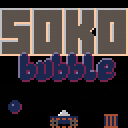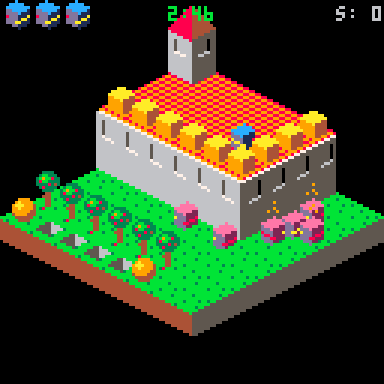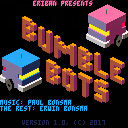

Sokoban with a twist! The box pusher is always in a bubble. Which boxes it can see and push depends on the bubble it is in.
Now with online Hall of Fame! For a chance of eternal glory, you need to play the game at my website as from there it can connect to the Hall of Fame service.



Features:
- 24 levels
- Music and sound effects
- Hard and easy mode
- Undo (only in easy mode)
- Progress storage
- Level selection menu






Sokoban with a twist! The box pusher is always in a bubble. Which boxes it can see and push depends on the bubble it is in.
The game still needs polishing, but the basic idea seems sound. Only small puzzles so far, but they are already challenging. Can you solve all eight puzzles?


Root to Remain is on the surface a game about planting seeds and growing trees. Ride the river of randomness to achieve your goal.
The rules and game play should be self-explanatory. Should things be unclear, let me know.
One tip for power players: holding X while moving the cursor lets you select fruits and trees, even when there is a seed in the given direction. This can be useful in situations where a fast rooting action is of critical importance.




Where to Root is a spin-off of this year's Global Game Jam, which had as theme "root".
The basic mechanics of the game are:
- Trees grow, sprout seeds, drop seeds and disappear
- Seeds travel in a fixed direction and can take root to grow into new trees
- Each player can only decide when (and where) to root their seeds
It's an area control game with quite some randomness.
You will need a plan, skill, persistence and a bit of luck.
You cannot control where seeds sprout and the direction they move in.
However, you can decide which seeds to root and when and where to do so.
Are you able to get a tree in each of the target areas?
The game is still a work in progress but already features eleven levels.

Pico Garden is a slow-play, low interaction, screen-saver game.
It features a garden that evolves based on Conway's Game of Life.
There is some additional randomness and (minimal) player interaction.
It is a game for dreamers, grinders, slackers and thinkers.
The latest version adds an adaptive, evolving music track.
You do not have to do anything. Your garden will grow by itself.
However, you can occasionally tend your garden if you want to.
If you time this carefully, this will revitalise it so you can enjoy it for longer.
You can use the up and down keys to speed-up and slow-down time.
You can use the left and right keys to change the view.
There's even a fancy plot that shows how well your garden is doing.


Martian Dice is an online multi-player dice game. It lets you:
- Play with your friends
- Play with strangers or
- Play against a bot

This is a reproduction of the physical dice game Martian Dice.
Unfortunately, this game cannot be played from the BBS. For different clients to talk to each other the game needs to connect to a cloud-hosted service, which requires additional Javascript code. You can play the game from my homepage though. The in-game QR code also takes you there.
History
This PICO-8 game really evolved by accident. After playing Martian Dice with friends I wondered what the optimal play was and how much points you can expect to score each turn. So I built a bot in Python that maximises the expected score each turn. Next I figured it would be a good vehicle for me to try out WebSockets. As I also wanted some experience with React, I first built a React client. Then I started dabbling with sprites for the die faces and realized it's a good fit for PICO-8. And here we are...



On Firefox and Safari, the PICO-8 screen can go beyond the bottom boundary of the div that encloses it. When this happens, the bottom part of the PICO-8 screen can be masked/covered by elements below the player. On Chrome it always renders okay.
This screenshot shows what goes wrong:

This is the HTML template as exported by PICO-8 (0.2.0e). I only changed it to add some text below the player, and changed the background color of the "p8_frame_0" div to red.
The page is accessible here for anyone who wants to quickly try and reproduce it. Whether or not the problem occurs depends on the size of the view port. You may have to resize your browser window.
I'd just like to share that I implemented a tracker for the Gamebuino inspired on PICO-8's tracker. It is a bit more primitive, as the Gamebuino console only supports 10-bit audio. Furthermore to keep CPU load acceptable, some pragmatic choices had to be made in generating the audio samples. For example, all calculations are integer-based and only 8-bit multiplications are used. Custom instruments are also not fully supported. In particular, you cannot layer effects, e.g. apply a Vibrato effect on top of a Slide, or vice versa.
However, my tracker supports all instruments and effects available in PICO-8. With that, it is able to reproduce most PICO-8 songs. At least, I successfully managed to render all the songs that I tried to port.
In particular, I want to thank the following PICO-8 users for sharing their carts/music under a Creative Commons license:
- @Domarius: Alex Kidd
- @Gruber: For his music in The Lair and Winter Golf

Bumble Bots Re-Pair is a difficult action puzzle game. In the game you need to re-unite (re-pair) bots by fixing the paths they traverse. Can you complete all ten levels?

Credits
The idea for this game was created during this year's Global Game Jam, where the theme was "repair". It's a spin-off of the Robo Re-Pair game that we created during the jam.
The music was created by my brother and first used in my original Bumble Bots game (Low Rez).
Tips
The tiles that you are offered are randomly selected. However, you will always be offered tiles that fit somewhere on the grid. Furthermore, the tiles on offer will be unique. The order in which you place tiles and where you place them therefore matters. Exploit this to increase the odds that you get favourable tiles.







No points for originality here, but it's a fun programming exercise. I plan to port this to my Gamebuino device next.
v0.2
- Solved celebration
- "Reset" menu option
- "New puzzle" menu option
- Fancier graphics
v 0.1
The basic functionality is all there:
- Generation of random puzzles
- Ability to solve it
Still pending
- Final touches
Possibly:
- "Hint" menu option
- Difficulty indication



Less is more!
Here's a low resolution version of my Bumble Bots game. Fewer pixels, but a better game.
When porting the game to Gamebuino I had to reduce the resolution. Doing so forced me to remove some screen clutter as every pixel counts at 80x64. Also, I had to zoom into the levels. On the one hand, this made the game play slightly harder, as you cannot always see all enemies. On the other hand, it made the game play more immersive. In the original game, more than half of screen was black pixels. I actually like the game better at the lower resolution, so decided to revamp the original PICO-8 version. This is the result.



Recently I have been busy porting my PICO-8 Bumble Bots game to the Gamebuino game console. Gamebuino resembles PICO-8 in that it is also a console for making and playing retro-games with the emphasis on making them. Unlike PICO-8, the Gamebuino is a physical console based on an Arduino board. Here is a picture of a Gamebuino featuring my Bumble Bots game. (Btw, I "shopped" the picture to increase the brightness of the screen, but it's not a mock-up. This is a picture of the game actually running).

Porting my game has been a fun project. So far, I have ported all the game-play elements, and re-created nine of the sixteen levels. The coding is effectively done. The main work pending is porting the last seven levels. I am sharing my experiences here, as I hope that some of you find them interesting.
Gamebuino's resource limitations follow from its physical implementation and are mostly more tight than PICO-8's artificial limitations. The screen resolution of the Gamebuino is 80x64. Although it also supports 160x128, this resolution is not recommended. The details would be too small and drawing to the screen would require more CPU. CPU speed is anyhow a limiting factor. Just drawing an empty screen of 80x64 pixels at 25 FPS loads the CPU for 50%. On the PICO-8 I had no problem achieving 30 FPS, but realizing 25 FPS on the Gamebuino (with a more limited resolution) required a few optimizations. Also, unlike PICO-8, RAM-memory is scarce and you cannot really dynamically allocate memory. You are effectively restricted to global variables and the stack. This requires you to be more conscious of memory usage while you develop. Similar to the PICO-8, there are also limits to the size of the program, but Gamebuino games can be a bit larger. My game is near PICO-8's token limit, but will be less than 50% of the maximum size on the Gamebuino.
I found it very useful to first have created the game on the PICO-8 and then port it to the Gamebuino. For prototyping the PICO-8 is a much more friendly environment. PICO-8's code-run-debug cycle is faster. Lua is also a friendlier language than C/C++ which you need for the Gamebuino. A silly mistake in the C/C++ code can easily lead to a crash or (undetected) memory corruption. Also PICO-8's built-in sprite, sound and music editors make it easy and quick to create and adapt graphics and sounds. Creating images and sounds on the Gamebuino is more cumbersome. Fortunately, it was quite easy to port PICO-8 images to the Gamebuino. I was also able to port the sound effects I created, although this required a bit more work as Gamebuino's sound effect support is a bit more primitive.
In short, I found PICO-8 and Gamebuino to nicely complement each other. PICO-8 is an excellent environment to quickly prototype and evolve a game idea, and to get it out on the web. However, after that, it's great to port it to a physical device that you can hold in your hands and hand-over to friends to let them try it out.
See my post on the Gamebuino site for more details about the porting process.



Bumble Bots is a difficult puzzle action game. It features sixteen levels, ranging from pure action to challenging puzzles and anything in between.
The game is self-explanatory. You will encounter new elements and learn new tricks as you go along.
Be warned, this is a tough game. I expect only few players to reach the end. Are you one of them?
Challenges:
- Complete all 16 levels
- Beat the hi-score
- Beat the virtual hi-score
- Complete all 16 levels in one go
Did you reach the end? If so, feel free to share a screenshot of the end screen to proof it.











After wetting my toes in the Pico-8 pool with my Tile Swap game, I figured I should try a bigger game. It's still a WIP, but playable already, so I thought I'd share it.
The game is called Bumble Bots. The idea of the game is "stolen" from the Rolmops game developed by the team that I was part of in this year's Global Game Jam. The Jam's theme was "waves".





I'd like to share my first PICO-8 project. It's a puzzle game of my own design. You need to restore the puzzle by swapping pairs of tiles. The difficulty is that not all tiles can be swapped. It's up to you to discover which tiles can be swapped. Figuring this out is only the first step. The real challenge has then only just begun!
v0.2 After solving the puzzle (within a reasonable amount of moves) you now get a solve key, which grants you entry into the game's Hall of Fame. Capture it. You can reply to this thread with the screen capture. The keys are unique, so don't "re-use" the key of someone else. Furthermore, you really need to solve the puzzle. You cannot cheat by inspecting the source code either.









 5 comments
5 comments








